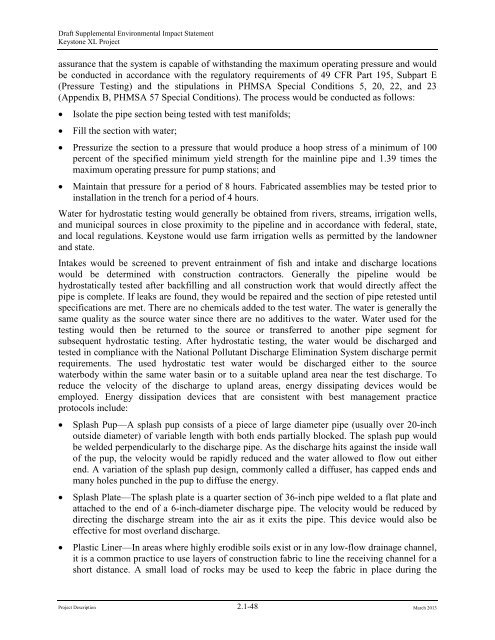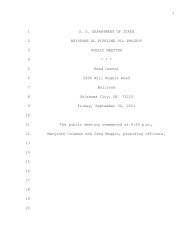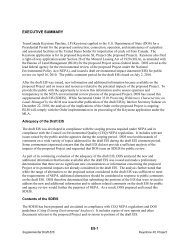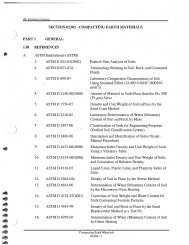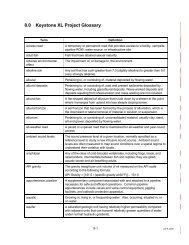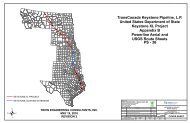2.1 Overview of the Proposed Project - Keystone XL pipeline - US ...
2.1 Overview of the Proposed Project - Keystone XL pipeline - US ...
2.1 Overview of the Proposed Project - Keystone XL pipeline - US ...
You also want an ePaper? Increase the reach of your titles
YUMPU automatically turns print PDFs into web optimized ePapers that Google loves.
Draft Supplemental Environmental Impact Statement<strong>Keystone</strong> <strong>XL</strong> <strong>Project</strong>assurance that <strong>the</strong> system is capable <strong>of</strong> withstanding <strong>the</strong> maximum operating pressure and wouldbe conducted in accordance with <strong>the</strong> regulatory requirements <strong>of</strong> 49 CFR Part 195, Subpart E(Pressure Testing) and <strong>the</strong> stipulations in PHMSA Special Conditions 5, 20, 22, and 23(Appendix B, PHMSA 57 Special Conditions). The process would be conducted as follows:• Isolate <strong>the</strong> pipe section being tested with test manifolds;• Fill <strong>the</strong> section with water;• Pressurize <strong>the</strong> section to a pressure that would produce a hoop stress <strong>of</strong> a minimum <strong>of</strong> 100percent <strong>of</strong> <strong>the</strong> specified minimum yield strength for <strong>the</strong> mainline pipe and 1.39 times <strong>the</strong>maximum operating pressure for pump stations; and• Maintain that pressure for a period <strong>of</strong> 8 hours. Fabricated assemblies may be tested prior toinstallation in <strong>the</strong> trench for a period <strong>of</strong> 4 hours.Water for hydrostatic testing would generally be obtained from rivers, streams, irrigation wells,and municipal sources in close proximity to <strong>the</strong> <strong>pipeline</strong> and in accordance with federal, state,and local regulations. <strong>Keystone</strong> would use farm irrigation wells as permitted by <strong>the</strong> landownerand state.Intakes would be screened to prevent entrainment <strong>of</strong> fish and intake and discharge locationswould be determined with construction contractors. Generally <strong>the</strong> <strong>pipeline</strong> would behydrostatically tested after backfilling and all construction work that would directly affect <strong>the</strong>pipe is complete. If leaks are found, <strong>the</strong>y would be repaired and <strong>the</strong> section <strong>of</strong> pipe retested untilspecifications are met. There are no chemicals added to <strong>the</strong> test water. The water is generally <strong>the</strong>same quality as <strong>the</strong> source water since <strong>the</strong>re are no additives to <strong>the</strong> water. Water used for <strong>the</strong>testing would <strong>the</strong>n be returned to <strong>the</strong> source or transferred to ano<strong>the</strong>r pipe segment forsubsequent hydrostatic testing. After hydrostatic testing, <strong>the</strong> water would be discharged andtested in compliance with <strong>the</strong> National Pollutant Discharge Elimination System discharge permitrequirements. The used hydrostatic test water would be discharged ei<strong>the</strong>r to <strong>the</strong> sourcewaterbody within <strong>the</strong> same water basin or to a suitable upland area near <strong>the</strong> test discharge. Toreduce <strong>the</strong> velocity <strong>of</strong> <strong>the</strong> discharge to upland areas, energy dissipating devices would beemployed. Energy dissipation devices that are consistent with best management practiceprotocols include:• Splash Pup—A splash pup consists <strong>of</strong> a piece <strong>of</strong> large diameter pipe (usually over 20-inchoutside diameter) <strong>of</strong> variable length with both ends partially blocked. The splash pup wouldbe welded perpendicularly to <strong>the</strong> discharge pipe. As <strong>the</strong> discharge hits against <strong>the</strong> inside wall<strong>of</strong> <strong>the</strong> pup, <strong>the</strong> velocity would be rapidly reduced and <strong>the</strong> water allowed to flow out ei<strong>the</strong>rend. A variation <strong>of</strong> <strong>the</strong> splash pup design, commonly called a diffuser, has capped ends andmany holes punched in <strong>the</strong> pup to diffuse <strong>the</strong> energy.• Splash Plate—The splash plate is a quarter section <strong>of</strong> 36-inch pipe welded to a flat plate andattached to <strong>the</strong> end <strong>of</strong> a 6-inch-diameter discharge pipe. The velocity would be reduced bydirecting <strong>the</strong> discharge stream into <strong>the</strong> air as it exits <strong>the</strong> pipe. This device would also beeffective for most overland discharge.• Plastic Liner—In areas where highly erodible soils exist or in any low-flow drainage channel,it is a common practice to use layers <strong>of</strong> construction fabric to line <strong>the</strong> receiving channel for ashort distance. A small load <strong>of</strong> rocks may be used to keep <strong>the</strong> fabric in place during <strong>the</strong><strong>Project</strong> Description <strong>2.1</strong>-48 March 2013


